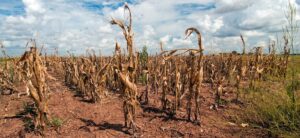Physical Address
23,24,25 & 26, 2nd Floor, Software Technology Park India, Opp: Garware Stadium,MIDC, Chikalthana, Aurangabad, Maharashtra – 431001 India
Physical Address
23,24,25 & 26, 2nd Floor, Software Technology Park India, Opp: Garware Stadium,MIDC, Chikalthana, Aurangabad, Maharashtra – 431001 India

By Aayushi Sharma
A recent study published in Nature, on “Global projections of flash drought show increased risk in a warming climate” found that incidents of flash drought expected to increase worldwide.
A similar study published in journal Science found that over the past six decades, ‘flash droughts’ have become more common in 74% of the world’s regions, mostly as a result of human-caused climate change.
Droughts are predicted to start more quickly in high-emission situations. Flash droughts are difficult to forecast because they replace slower onslaughts with brief dry spells.
What are flash droughts? What is the difference between droughts and flash droughts?
A drought is a stretch of time when precipitation levels are below average in a given area or region. Lack of sufficient precipitation, such as rain or snow, can result in decreased soil or groundwater moisture, reduced streamflow, crop damage, and a general water scarcity. The costliest weather occurrences, after hurricanes, are droughts.
In contrast to slow-evolving drought, which is brought on by a decrease in precipitation, flash drought happens when low precipitation is coupled with unusually high temperatures (such as heat waves), strong winds, and/or changes in radiation.

Flash drought has recently become an active and rapidly growing area of research within climate, agricultural, and ecological studies because of the large environmental and socioeconomic impacts it can cause. The term “flash drought” was developed in the early 2000s to call attention to a subgroup of droughts that contradict the widely held belief that drought is a creeping occurrence that can take months or years to develop. The two ways that flash droughts have been described are as a multi-week period of rapidly intensifying drought or as a short-lived yet severe event where soil moisture entirely depletes.
It is essential to determine the relative contributions of the two main causes of flash drought—a decrease in precipitation and an increase in evaporative demand—to changes in the frequency of these events under various future climate scenarios. The consequences of a flash drought can be seen within days or weeks, as contrasted to the gradual onset of a long drought, which can last months or even years due to large-scale climate trends like El Nino.
Socioeconomic consequences of Flash droughts
Compared to seasonal ones, heatwaves during flash droughts are more extreme. Tropical areas including Sub-Saharan Africa, Southeast Asia, the western coast of South America, Southern Australia, and the Amazon basin are where these have been observed the most frequently.
Future dry spells might harm crops and jeopardize the nation’s food security, which could have severe effects in particular for farmers in these regions who rely on rain-fed agriculture.

The rainy seasons in the tropics keep the soil and vegetation hydrated. The equatorial heat, however, can desiccate the earth beyond what is expected when rains fail suddenly. Humans may not have much time to adapt during flash droughts, such as changing water sources or putting out wildfires.
The transition to flash droughts, the researchers said, could have irreversible impacts on ecosystems owing to their inability to adapt to a sudden lack of water and extreme heat. Current approaches to predicting droughts use longer time scales, making forecasting flash droughts difficult.
Researchers discovered that all of the examined flash droughts were preceded by abrupt rises in evapotranspiration rates brought on by variations in temperature, wind, and radiation. Prior to the start of the drought, soil moisture was abundant, but it dropped as evapotranspiration rates increased.
Scenario of Flash Droughts in India
India is the seventh-largest nation in the world, with a total area of roughly 3.28 million square kilometers. India is classified into 24 major river basins based on various climate variables by India-WRIS (2014). The current analysis measures the frequency of flash droughts across 24 of the nation’s major river basins.
Extreme weather and climatic conditions adversely affect Indians’ ability to produce food, earn a living from farming, and live in general comfort. According to a study, India will experience hot and dry extremes more frequently than ever before by the end of the twenty-first century. This can result in an increase of flash droughts of about seven fold.

Map of drought prone districts of India
Ecological impacts of Flash droughts
Flash droughts can have a variety of effects, including stress on the vegetation, decreased crop yields, reduced water supply, ecological deterioration, and an increased danger of fires. These effects could be bigger, different in kind, or both from those of typical droughts. The duration of the drought and the timing of the fast intensification determine the effects of a flash drought. During sensitive periods of the growing season, rapid intensification may cause consequences to manifest more quickly than can be properly controlled.
Impacts to sectors other than agriculture have received comparatively little attention. Some professionals who deal with water resources and/or ecosystem health may believe that flash droughts have little to no effects on their fields or that they have effects that converge with and resemble those experienced during longer-lasting droughts. However, neither these connections nor the opinions of practitioners have received in-depth research. The paucity of studies on the ecological and hydrological effects of flash droughts underscores the lack of knowledge on possible interactions and feedbacks between flash drought, the environment, and various practitioners, which may vary by region and season. Flash droughts has a negative influence on ecosystem health because it causes more wildfires, lower vegetation productivity, and fewer animals.
References: